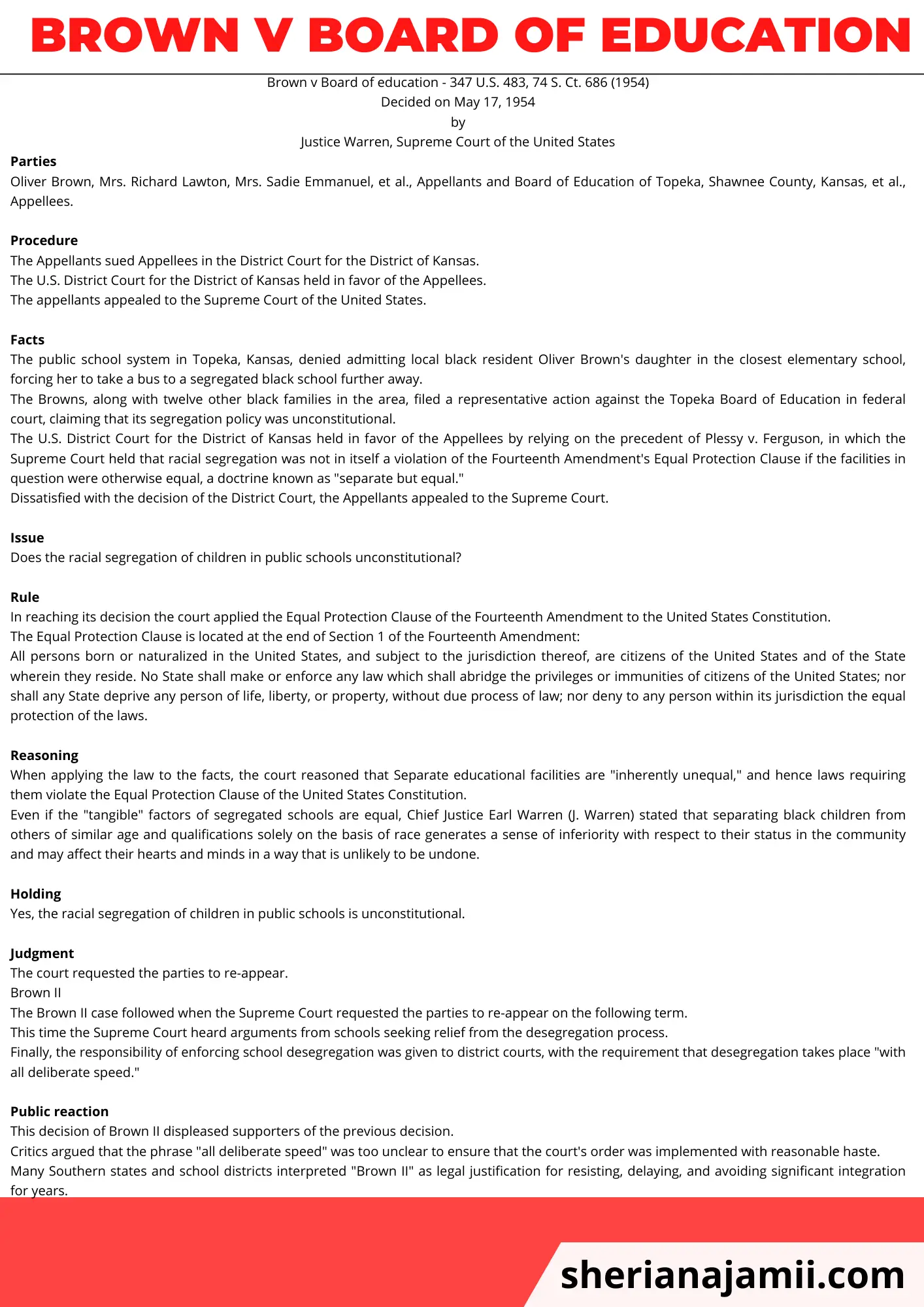here you will see the Brown v Board of Education case brief.
Brown v Board of education case is a landmark case in U.S constitutional law.
Brown v Board of education case paved the way for equal opportunity in U.S public schools regardless of race by declaring U.S. state laws establishing racial segregation in public schools unconstitutional.
Here I will share with you the Brown v Board of education case brief to help you understand everything you need to know about the Brown v Board of education case in a simple and accurate way.
Interested in learning how to write your own case brief? learn here
Transform Your Communication, Elevate Your Career!
Ready to take your professional communication skills to new heights? Dive into the world of persuasive business correspondence with my latest book, “From Pen to Profit: The Ultimate Guide to Crafting Persuasive Business Correspondence.”

What You’ll Gain:
Let’s get started
Jump to section
Brown v Board of education case brief
Brown v Board of education – 347 U.S. 483, 74 S. Ct. 686 (1954)
Decided on May 17, 1954
by
Justice Warren, Supreme Court of the United States
Parties
Oliver Brown, Mrs. Richard Lawton, Mrs. Sadie Emmanuel, et al., Appellants and Board of Education of Topeka, Shawnee County, Kansas, et al., Appellees.
Procedure
The Appellants sued Appellees in the District Court for the District of Kansas.
The U.S. District Court for the District of Kansas held in favor of the Appellees.
The appellants appealed to the Supreme Court of the United States.
Facts
The public school system in Topeka, Kansas, denied admitting local black resident Oliver Brown’s daughter in the closest elementary school, forcing her to take a bus to a segregated black school further away.
The Browns, along with twelve other black families in the area, filed a representative action against the Topeka Board of Education in federal court, claiming that its segregation policy was unconstitutional.
The U.S. District Court for the District of Kansas held in favor of the Appellees by relying on the precedent of Plessy v. Ferguson, in which the Supreme Court held that racial segregation was not in itself a violation of the Fourteenth Amendment’s Equal Protection Clause if the facilities in question were otherwise equal, a doctrine known as “separate but equal.”
Dissatisfied with the decision of the District Court, the Appellants appealed to the Supreme Court.
Issue
Does the racial segregation of children in public schools unconstitutional?
Rule
In reaching its decision the court applied the Equal Protection Clause of the Fourteenth Amendment to the United States Constitution.
The Equal Protection Clause is located at the end of Section 1 of the Fourteenth Amendment:
All persons born or naturalized in the United States, and subject to the jurisdiction thereof, are citizens of the United States and of the State wherein they reside. No State shall make or enforce any law which shall abridge the privileges or immunities of citizens of the United States; nor shall any State deprive any person of life, liberty, or property, without due process of law; nor deny to any person within its jurisdiction the equal protection of the laws.
Reasoning
When applying the law to the facts, the court reasoned that Separate educational facilities are “inherently unequal,” and hence laws requiring them violate the Equal Protection Clause of the United States Constitution.
Even if the “tangible” factors of segregated schools are equal, Chief Justice Earl Warren (J. Warren) stated that separating black children from others of similar age and qualifications solely on the basis of race generates a sense of inferiority with respect to their status in the community and may affect their hearts and minds in a way that is unlikely to be undone.
Holding
Yes, the racial segregation of children in public schools is unconstitutional.
Judgment
The court requested the parties to re-appear.
Brown II
The Brown II case followed when the Supreme Court requested the parties to re-appear on the following term.
This time the Supreme Court heard arguments from schools seeking relief from the desegregation process.
Finally, the responsibility of enforcing school desegregation was given to district courts, with the requirement that desegregation takes place “with all deliberate speed.”
Public reaction
This decision of Brown II displeased supporters of the previous decision.
Critics argued that the phrase “all deliberate speed” was too unclear to ensure that the court’s order was implemented with reasonable haste.
Many Southern states and school districts interpreted “Brown II” as legal justification for resisting, delaying, and avoiding significant integration for years.
Read the full Decision here
other case briefs to read
- Marbury versus Madison case brief
- Hamer v Sidway case brief
- Pennoyer v Neff case brief
- Pierson v Post case brief
- Hawkins v Mcgee case brief
- Tinker v des Moines case brief
- Duncan v Louisiana case brief
- Garrett v Dailey case brief
- Lucy v Zehmer case brief
- Griswold v Connecticut case brief
- Katz v United States case brief
- Riley v California case brief | United States v. Wurie
- Leonard v Pepsico case brief
- Wickard v Filburn case brief
- District of Columbia v. Heller case brief
- Gonzales v Raich case brief
- Shelley v Kraemer case brief
- Tennessee v Garner case brief




